 Curated content -posts which collect and share content from a range of different sources- has long been one of the most underrated elements of the content marketing mix. Curated posts can attract a lot of user engagement, and are used by a wide range of media outlets to present social media posts, articles, or other content which relate to a specific topic in a single concise, digestible format. Not only that, but they can be put together easily and quickly, shared across a wide range of platforms, and be optimized to maximise their SEO value.
Curated content -posts which collect and share content from a range of different sources- has long been one of the most underrated elements of the content marketing mix. Curated posts can attract a lot of user engagement, and are used by a wide range of media outlets to present social media posts, articles, or other content which relate to a specific topic in a single concise, digestible format. Not only that, but they can be put together easily and quickly, shared across a wide range of platforms, and be optimized to maximise their SEO value.
One of the most popular tools for content curation is Storify, which combines a number of efficient search tools with an intuitive user interface to make the process easier. The platform, which is now owned by Adobe, was first launched in 2010 and has gone on to amass around 23 million unique monthly visitors. Content produced on Storify can be shared on your own page on the site, or embedded onto any publishing platform that supports html, such as WordPress.
A number of schools already use the platform for creating posts around various topics, but what kind of curated content is most likely to engage prospective students? Read on to find out a number of ways to use Storify in your online recruitment initiatives.
1. Storify Can Help You Maximise Student Engagement from Open Days
One of the best and most direct ways of using Storify to connect and engage with potential recruits is to build posts around recruitment related events such as open days, campus tours, and fairs. Visitors to your school are bound to share their experience on Facebook, Twitter, Snapchat and countless other social media platforms. Collecting the best posts on Storify and publishing them on your school’s website will remind prospects who attended just how much they enjoyed their experience, as well as showing other prospective applicants what they missed out on.
Example: The University of Tampa created a Storify post around their Open House events and embedded it in the admissions section on their website, even making the post available as a slideshow for easy viewing.
The content was curated by searching for social media posts which utilized their #UTOpenHouse hashtag, and includes a good mix of posts from different platforms such as Instagram and Twitter.
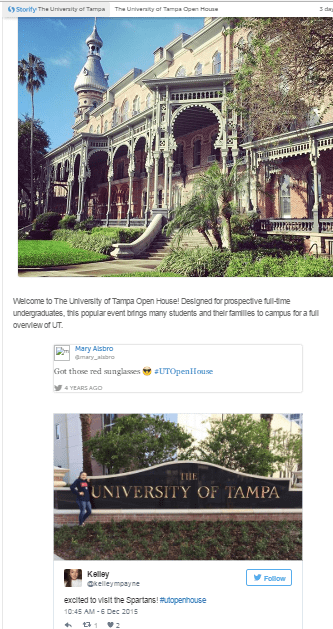
Perhaps the best part about promoting open days using Storify is that the platform can automatically send notifications to anyone whose social media posts are included in the story. This means that prospective leads whose posts you’ve included- and who likely already have a positive view of your school- will be alerted of the article directly, making them far more likely to view it and strengthening their connection with your institution.
To maximise their education lead generation potential, open day Storify posts should be put together quickly following your event. You should also consider linking to your admissions pages within the body text of your post, perhaps even including information about other upcoming recruitment activities.
Example: The University of Reading regularly creates Storify posts about their open days. The school are always sure to let readers know when the next one is happening at the end of the post, as well as providing links for prospective students who want to book campus tours.

2. Highlight Your Accepted Students’ Delight on Social Media to Generate New Leads
Another brilliant way to use Storify get prospective students excited about applying to your school is build Storify posts around new enrollments. Seeing peers who are excited to attend your school will reinforce a positive image of your brand among your target audience and encouraging them to pursue their interest further.
For instance, after you send out your offers of admission, you could create a post from the reactions of applicants on social media. For best results, try and encourage your faculty, different departments, and current students to get involved too, taking the time to post on their social media accounts to welcome the new members of their school community. This will ensure a wide variety of quality posts from a range of sources.
Example: Brown University created this Storify post around the admissions offers for the class of 2019. As you can see, they have chosen a good mix of Tweets that include students, their loved ones, and organisations from the wider school community.

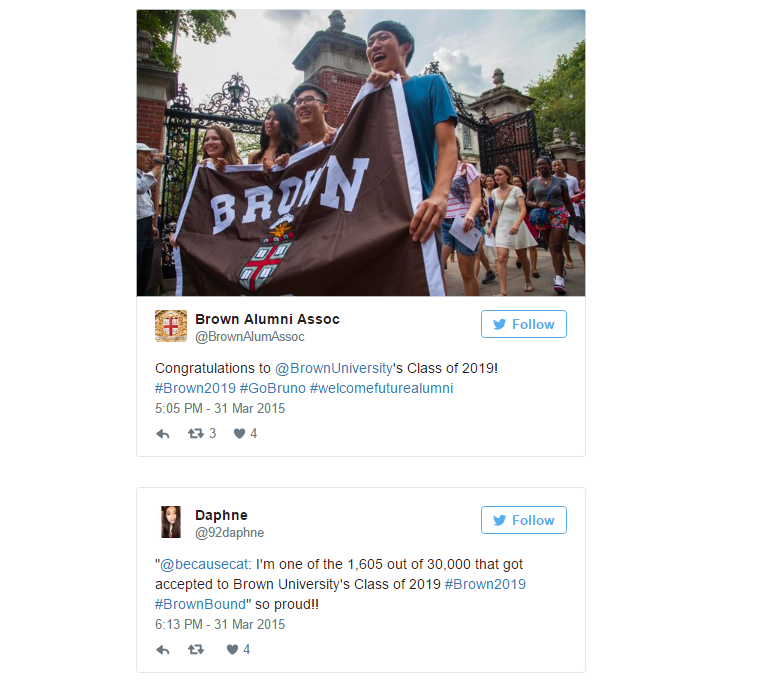
Of course, each country’s admissions system is different, but your school can still find ways of creating Storify posts around the process. In the UK for instance, where applicants are admitted based on their UCAS results, many schools create similar posts around the time results are released and offers are finalised.
Example: The University of Birmingham composed a Storify around 2016 A Level Results day. The school used their #hellobrum hashtag to source posts.

3. Give Prospective Students an Inside Look at What Their First Few Weeks at Your School Will Be Like
New students can continue to provide plenty of material for Storify posts as they prepare to enter your school. Move-in days, orientation weeks, and other events that take place on campuses around the world each year are all bound to generate plenty of social media activity. The enthusiasm that new students express when starting their course will ensure plenty of positivity, while events like these will resonate heavily with prospective applicants, who can look at these posts and begin to picture themselves in the same position next year.
Example: Rice University curated an excellent Storify post around their 2016 orientation week, which drew on a range of different social media sites to create an eclectic collection of posts, photos and videos.

Including student tweets, Instagram posts and other social media snippets based around the reactions to events like these can be very effective, but you should also consider including more informative content. Collecting blog posts, guides, and other material which is relevant to new arrivals can lend your post a bit more substance, providing help for new students viewing the post as well as additional information which might interest potential applicants.
Example: York University’s Housing Services page includes a Storify post which collects a number of blog posts from the department and current students, each of which feature handy tips for incoming students about choosing your accommodation and preparing to make the move.
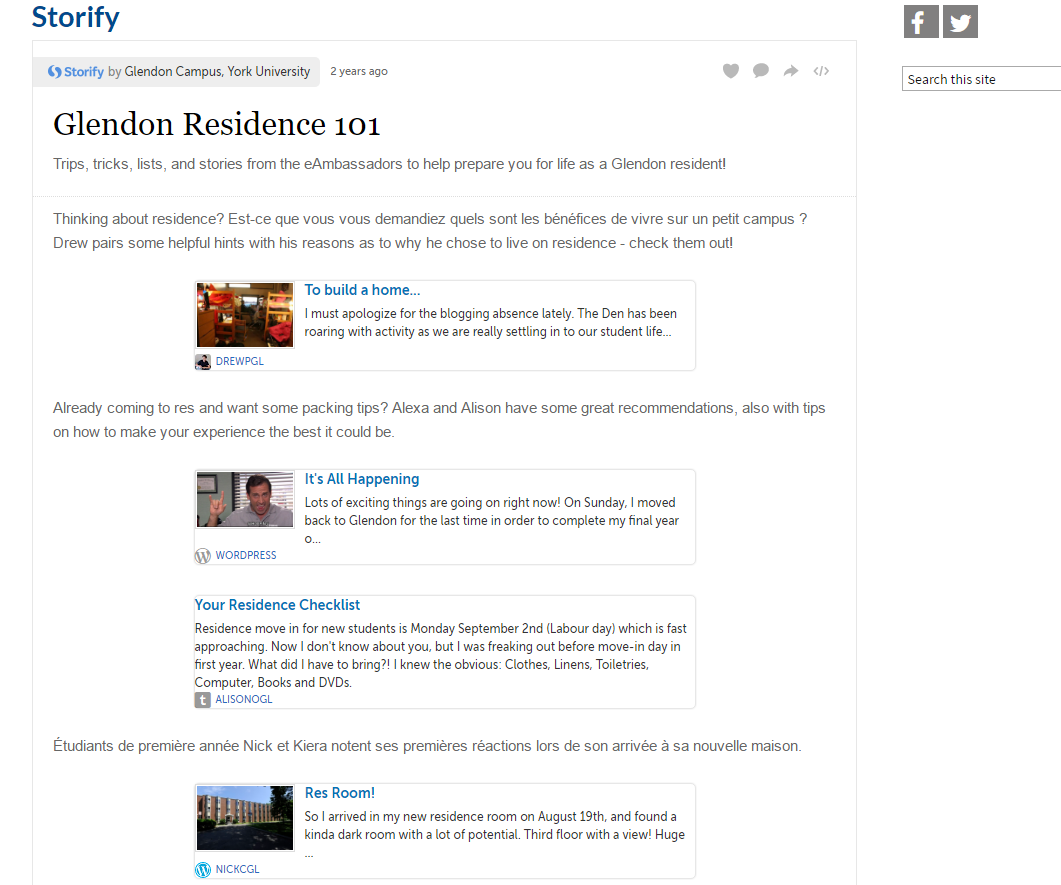
4. Create Posts Around Special Events to Show Potential Applicants What They’re Missing
Throughout the academic year, there are bound to be a whole slew of events that will attract serious engagement from your school community online. Everything from social events, to graduation ceremonies, and even academic conferences are all ripe for creating Storify posts that will resonate with potential leads. An academic events like a conference, for instance, can be presented ‘as it happened’ allowing interested readers to catch up on what they missed.
Example: The University of Nottingham created a post a round the faculty of Social Science’s EU Referendum debate in April of this year. The post presented some of the key talking points in order to give readers a full picture of the debate as a whole.


While more informal, socially oriented events can take a more casual approach than this, following a narrative structure can still be useful, helping to make the post flow better for readers. Again, including posts from a range of sites, and in a variety of formats, is also vital to ensure you appeal to the broadest audience possible.
Example: This Storify post documenting the University of Braford’s end of year Game Day adopts a fun, causal tone which perfectly suits the subject, while also featuring a wide variety of colorful posts from different sources.
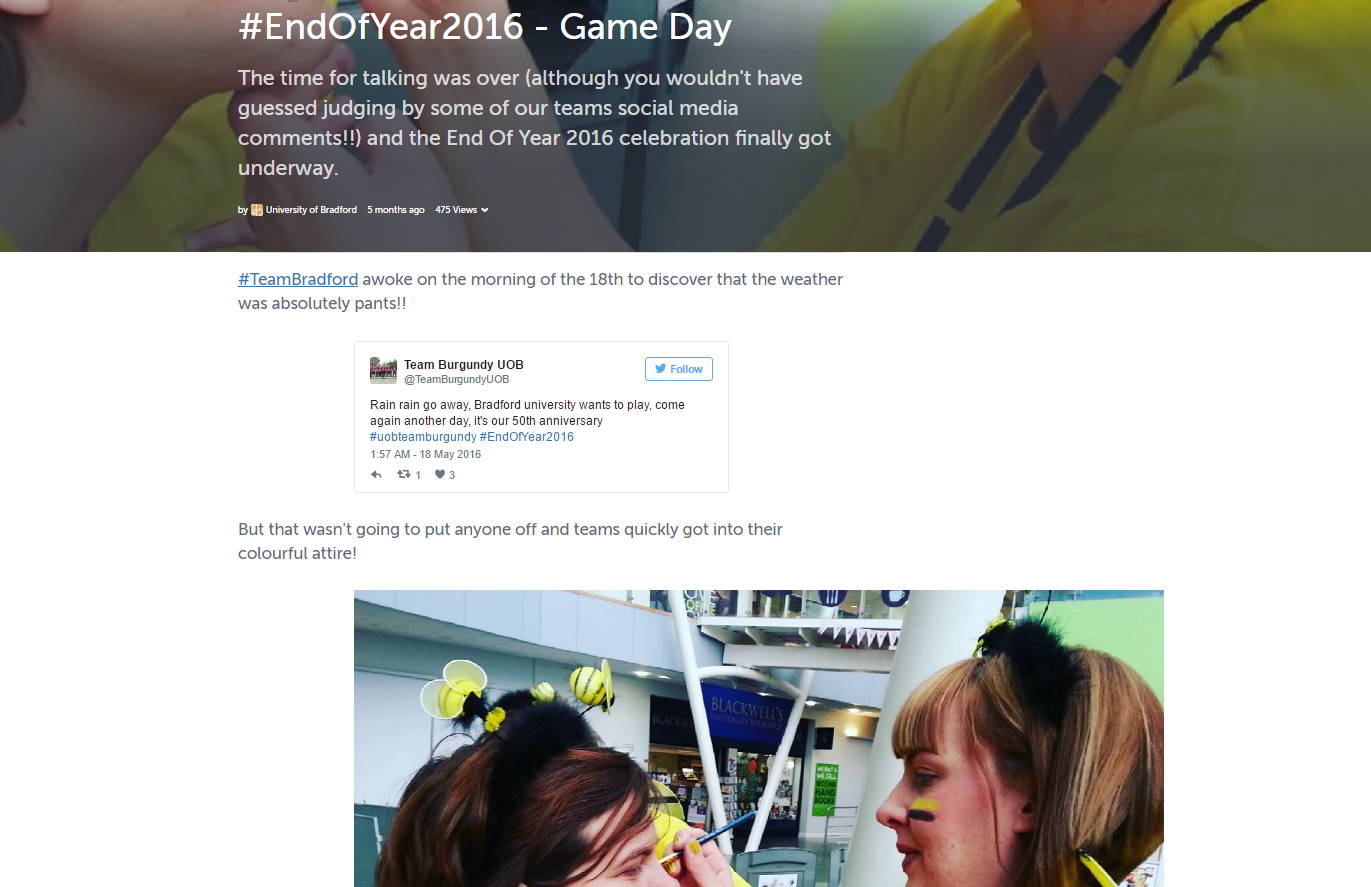

5. Use Storify To Highlight Newsworthy Events At Your School
Storify can also provide you to with a way to take advantage of publicity generated by noteworthy happenings around your school. Whether it’s a new research innovation, the opening of a new building or facility, or even the success of an alumnus, any news which attracts widespread attention for your school can raise awareness and give you a valuable visibility boost that will help you generate quality student leads.
Example: Cardiff University took advantage of Storify when the 2014 Research Excellence Framework rankings, which evaluate the research of UK universities, placed it in the top 5 for the first time. An improvement in your placement in university rankings can provide a great fillip to schools, and Storify posts are just one way to capitalise on it.

Of course, not every school will have events that capture mass media or social media attention like this. However, that doesn’t necessarily mean the platform isn’t for you. Many schools regularly use it to curate roundups and ‘best-of’ posts which collate any notable blogs posts, social stories, and other items that might interest potential leads. Posts like these can be created on an annual, monthly or even weekly basis depending on how much material you have, and are a great way for institutions of any size, from large universities to small community colleges, to shine a fresh light on their recent progress and celebrate how far they’ve come.
Example: This post created by Centre College provides readers with a review of some of the most notable posts the school has made in the previous year, which include academic highlights, sporting achievements and special events.
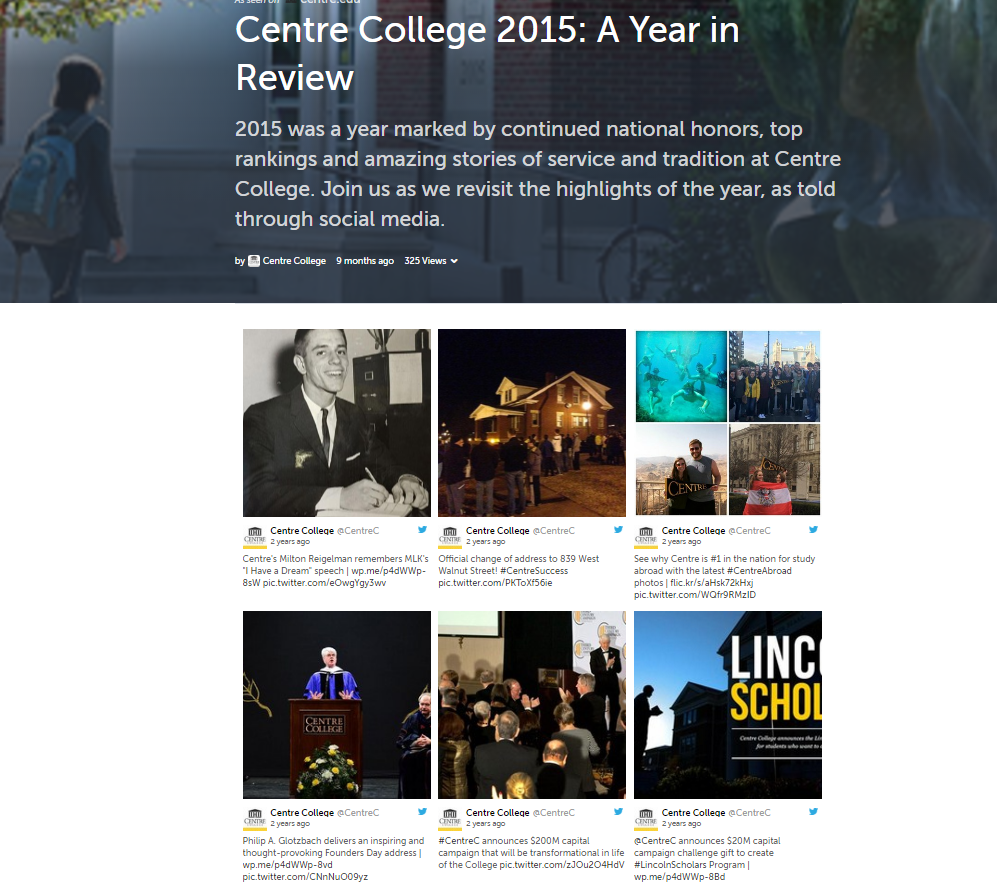
With so many different options to choose from, you can how valuable a role Storify and curated content could potentially play in your student recruitment content strategy. The platform has built-in blogging capabilities, and you can search for content from its database by targeting specific search terms. Many schools use branded hashtags for this purpose, although trying a few different terms can be useful, as it will give you results from more diverse sources. For best results, adding your own narrative text which incorporates strategic linked keywords is also advisable, as it will help to boost the SEO performance of your posts. This will contribute to maximising the visibility of your Storify content and turning it into an important part of your overall content marketing strategy.
Have you created Storify posts for your school? What types of content do you find work best on the platform? Leave a comment below and tell us about your experiences.








